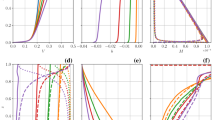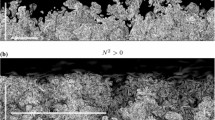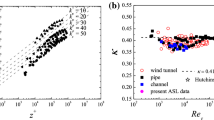Abstract
A field investigation of the mean streamwise length scale Lx of large-scale structures and the convection velocity is performed in a high-Reynolds-number (Reτ ~ 106) atmospheric surface layer (ASL). Based on selected high-quality synchronous data obtained at different streamwise positions, the length scale Lx and global convection velocity Uc are extracted in the logarithmic region of the near-neutral ASL at heights of 0.9 m, 1.71 m, 3.5 m, and 5 m. It is found that Uc values are approximately 16% greater than the local mean streamwise velocity component U, and the value of Lx obtained from spatially-separated measurements is greater than the results estimated from Taylor’s hypothesis using the value of U at the four heights. The mean relative difference between the value of Lx and the results estimated by Taylor’s hypothesis using the value of U is approximately 15%. However, the relative difference between the value of Lx and the results estimated from Taylor’s hypothesis using the convection velocity Uc instead of the mean streamwise velocity component U is reduced to 1 ± 6% (≈ zero). Thus, the convection velocity Uc is more appropriate than the mean streamwise velocity component U in obtaining Lx values in the near-neutral ASL.













Similar content being viewed by others
References
Abe H, Kawamura H, Choi H (2004) Very large-scale structures and their effects on the wall shear-stress fluctuations in a turbulent channel flow up to Re τ = 640. J Fluid Eng 126:835–843
Anderson W, Meneveau C (2010) A large-eddy simulation model for boundary-layer flow over surfaces with horizontally resolved but vertically unresolved roughness elements. Boundary-Layer Meteorol 137:397–415
Anderson WC, Basu S, Letchford CW (2007) Comparison of dynamic subgrid-scale models for simulations of neutrally buoyant shear-driven atmospheric boundary layer flows. Environ Fluid Mech 7:195–215
Anderson W, Passalacqua P, Porté-Agel F, Meneveau C (2012) Large-eddy simulation of atmospheric boundary-layer flow over fluvial-like landscapes using a dynamic roughness model. Boundary-Layer Meteorol 144:263–286
Atkinson C, Buchmann NA, Soria J (2015) An experimental investigation of turbulent convection velocities in a turbulent boundary layer Flow. Flow Turbul Combust 94:79–95
Balakumar B, Adrian R (2007) Large-and very-large-scale motions in channel and boundary-layer flows. Philos Trans R Soc A 365:665–681
Bou-Zeid E, Higgins C, Huwald H, Meneveau C, Parlange MB (2010) Field study of the dynamics and modelling of subgrid-scale turbulence in a stable atmospheric surface layer over a glacier. J Fluid Mech 665:480–515
Calaf M, Hultmark M, Oldroyd H, Simeonov V, Parlange M (2013) Coherent structures and the k −1 spectral behaviour. Phys Fluids 25:125107
Choi H, Moin P (1990) On the space–time characteristics of wall-pressure fluctuations. Phys Fluids A 2:1450–1460
Clauser FH (1956) The turbulent boundary layer. Adv Appl Mech 4:1–51
Claussen M (1985) A model of turbulence spectra in the atmospheric surface layer. Boundary-Layer Meteorol 33:151–172
Coleman HW, Steele WG (2009) Experimentation, validation, and uncertainty analysis for engineers. Wiley, New York
Davidson P, Nickels T, Krogstad P-Å (2006) The logarithmic structure function law in wall-layer turbulence. J Fluid Mech 550:51–60
Davies P, Fisher M, Barratt M (1963) The characteristics of the turbulence in the mixing region of a round jet. J Fluid Mech 15:337–367
de Kat R, Ganapathisubramani B (2015) Frequency-wavenumber mapping in turbulent shear flows. J Fluid Mech 783:166–190
Del Álamo JC, Jiménez J (2009) Estimation of turbulent convection velocities and corrections to Taylor’s approximation. J Fluid Mech 640:5–26
Dennis DJ, Nickels TB (2008) On the limitations of Taylor’s hypothesis in constructing long structures in a turbulent boundary layer. J Fluid Mech 614:197–206
Dennis DJ, Nickels TB (2011a) Experimental measurement of large-scale three-dimensional structures in a turbulent boundary layer. Part 1. Vortex packets. J Fluid Mech 673:180–217
Dennis DJ, Nickels TB (2011b) Experimental measurement of large-scale three-dimensional structures in a turbulent boundary layer. Part 2. Long structures. J Fluid Mech 673:218–244
Falco R (1977) Coherent motions in the outer region of turbulent boundary layers. Phys Fluids 20:S124–S132
Fang J, Porté-Agel F (2015) Large-eddy simulation of very-large-scale motions in the neutrally stratified atmospheric boundary layer. Boundary-Layer Meteorol 155:397–416
Favre A, Gaviglio J, Dumas R (1957) Space–time double correlations and spectra in a turbulent boundary layer. J Fluid Mech 2:313–342
Favre A, Gaviglio J, Dumas R (1958) Further space–time correlations of velocity in a turbulent boundary layer. J Fluid Mech 3:344–356
Foken T, Göckede M, Mauder M, Mahrt L, Amiro B, Munger W (2004) Post-field data quality control. In: Lee X, Massman WJ, Law BE (eds) Handbook of micrometeorology. A guide for surface flux measurements, Kluwer, Dordrecht, pp 181–208
Ganapathisubramani B, Hutchins N, Hambleton W, Longmire E, Marusic I (2005) Investigation of large-scale coherence in a turbulent boundary layer using two-point correlations. J Fluid Mech 524:57–80
Geng C, He G, Wang Y, Xu C, Lozano-Durán A, Wallace JM (2015) Taylor’s hypothesis in turbulent channel flow considered using a transport equation analysis. Phys Fluids 27:025111
Goldschmidt V, Young M, Ott E (1981) Turbulent convective velocities (broadband and wavenumber dependent) in a plane jet. J Fluid Mech 105:327–345
Grant H (1958) The large eddies of turbulent motion. J Fluid Mech 4:149–190
Guala M, Hommema S, Adrian R (2006) Large-scale and very-large-scale motions in turbulent pipe flow. J Fluid Mech 554:521–542
Guala M, Metzger M, McKeon B (2011) Interactions within the turbulent boundary layer at high Reynolds number. J Fluid Mech 666:573–604
He G, Jin G, Yang Y (2017) Space–time correlations and dynamic coupling in turbulent flows. Annu Rev Fluid Mech 49:51–70
Higgins CW, Froidevaux M, Simeonov V, Vercauteren N, Barry C, Parlange MB (2012) The effect of scale on the applicability of Taylor’s frozen turbulence hypothesis in the atmospheric boundary layer. Boundary-Layer Meteorol 143:379–391
Högström U (1990) Analysis of turbulence structure in the surface layer with a modified similarity formulation for near neutral conditions. J Atmos Sci 47:1949–1972
Hunt JC, Morrison JF (2000) Eddy structure in turbulent boundary layers. Eur J Mech (B/Fluids) 19:673–694
Hutchins N, Marusic I (2007a) Evidence of very long meandering features in the logarithmic region of turbulent boundary layers. J Fluid Mech 579:1–28
Hutchins N, Marusic I (2007b) Large-scale influences in near-wall turbulence. Philos Trans R Soc A 365:647–664
Hutchins N, Monty J, Ganapathisubramani B, Ng H, Marusic I (2011) Three-dimensional conditional structure of a high-Reynolds-number turbulent boundary layer. J Fluid Mech 673:255–285
Hutchins N, Chauhan K, Marusic I, Monty J, Klewicki J (2012) Towards reconciling the large-scale structure of turbulent boundary layers in the atmosphere and laboratory. Boundary-Layer Meteorol 145:273–306
Jacob C, Anderson W (2016) Conditionally averaged large-scale motions in the neutral atmospheric boundary layer: insights for aeolian processes. Boundary-Layer Meteorol 162:21–41
Kader B, Yaglom A (1991) Spectra and correlation functions of surface layer atmospheric turbulence in unstable thermal stratification. In: Métais O, Lesieur M (eds) Turbulence and coherent structures. Kluwer Academic Publication, Dordrecht, pp 387–412
Kaimal J (1978) Horizontal velocity spectra in an unstable surface layer. J Atmos Sci 35:18–24
Kaimal JC, Finnigan JJ (1994) Atmospheric boundary layer flows: their structure and measurement. Oxford University Press, Oxford
Katul G, Chu C-R (1998) A theoretical and experimental investigation of energy-containing scales in the dynamic sublayer of boundary-layer flows. Boundary-Layer Meteorol 86:279–312
Kim K, Adrian R (1999) Very large-scale motion in the outer layer. Phys Fluids 11:417–422
Kim J, Hussain F (1993) Propagation velocity of perturbations in turbulent channel flow. Phys Fluids A Fluid Dyn 5:695–706
Krogstad P-Å, Kaspersen J, Rimestad S (1998) Convection velocities in a turbulent boundary layer. Phys Fluids 10:949–957
Kunkel GJ, Marusic I (2006) Study of the near-wall-turbulent region of the high-Reynolds-number boundary layer using an atmospheric flow. J Fluid Mech 548:375–402
Lauren MK, Menabde M, Seed AW, Austin GL (1999) Characterisation and simulation of the multiscaling properties of the energy-containing scales of horizontal surface-layer winds. Boundary-Layer Meteorol 90:21–46
Lee JH, Sung HJ (2011) Very-large-scale motions in a turbulent boundary layer. J Fluid Mech 673:80–120
Li Q, Zhi L, Hu F (2010) Boundary layer wind structure from observations on a 325 m tower. J Wind Eng Ind Aerodyn 98:818–832
Ligrani PM, Moffat RJ (1986) Structure of transitionally rough and fully rough turbulent boundary layers. J Fluid Mech 162:69–98
Lin C (1953) On Taylor’s hypothesis and the acceleration terms in the Navier–Stokes equation. Quart Appl Math 10:295–306
Liu H-Y, Bo T-L, Liang Y-R (2017a) The variation of large-scale structure inclination angles in high Reynolds number atmospheric surface layers. Phys Fluids 29:035104
Liu H, Wang G, Zheng X (2017b) Spatial length scales of large-scale structures in atmospheric surface layers. Phys Rev Fluids 2:064606
Lumley J (1965) Interpretation of time spectra measured in high-intensity shear flows. Phys Fluids 8:1056–1062
Marusic I, Kunkel GJ (2003) Streamwise turbulence intensity formulation for flat-plate boundary layers. Phys Fluids 15:2461–2464
Marusic I, McKeon B, Monkewitz P, Nagib H, Smits A, Sreenivasan K (2010) Wall-bounded turbulent flows at high Reynolds numbers: recent advances and key issues. Phys Fluids 22:065103
Marusic I, Monty JP, Hultmark M, Smits AJ (2013) On the logarithmic region in wall turbulence. J Fluid Mech 713:R3
Metzger M, McKeon B, Holmes H (2007) The near-neutral atmospheric surface layer: turbulence and non-stationarity. Philos Trans R Soc A 365:859–876
Moin P (2009) Revisiting Taylor’s hypothesis. J Fluid Mech 640:1–4
Monin AS, Yaglom AM (2013) Statistical fluid mechanics, volume II: mechanics of turbulence, vol 2. Courier Corporation, Chelmsford
Monty J, Chong M (2009) Turbulent channel flow: comparison of streamwise velocity data from experiments and direct numerical simulation. J Fluid Mech 633:461–474
Monty J, Stewart J, Williams R, Chong M (2007) Large-scale features in turbulent pipe and channel flows. J Fluid Mech 589:147–156
Pope SB (2001) Turbulent flows. IOP Publishing, Bristol
Powell DC, Elderkin C (1974) An investigation of the application of Taylor’s hypothesis to atmospheric boundary layer turbulence. J Atmos Sci 31:990–1002
Renard N, Deck S (2015) On the scale-dependent turbulent convection velocity in a spatially developing flat plate turbulent boundary layer at Reynolds number Re θ = 13000. J Fluid Mech 775:105–148
Robinson SK (1991) Coherent motions in the turbulent boundary layer. Annu Rev Fluid Mech 23:601–639
Sillero JA, Jiménez J, Moser RD (2014) Two-point statistics for turbulent boundary layers and channels at Reynolds numbers up to δ + ≈ 2000. Phys Fluids 26:105109
Taylor GI (1938) The spectrum of turbulence. Proc R Soc Lond A 164:476–490
Tennekes H, Lumley JL (1972) A first course in turbulence. MIT Press, Cambridge
Thuillier R, Lappe U (1964) Wind and temperature profile characteristics from observations on a 1400 ft tower. J Appl Meteorol 3:299–306
Townsend AA (1976) The structure of turbulent shear flow. Cambridge University Press, Cambridge
Tutkun M, George WK, Delville J, Stanislas M, Johansson P, Foucaut J-M, Coudert S (2009) Two-point correlations in high Reynolds number flat plate turbulent boundary layers. J Turbul 10:N21
Vallikivi M, Ganapathisubramani B, Smits A (2015) Spectral scaling in boundary layers and pipes at very high Reynolds numbers. J Fluid Mech 771:303–326
Volino R, Schultz M, Flack K (2007) Turbulence structure in rough-and smooth-wall boundary layers. J Fluid Mech 592:263–293
Wang G, Zheng X (2016) Very large scale motions in the atmospheric surface layer: a field investigation. J Fluid Mech 802:464–489
Wilczak JM, Oncley SP, Stage SA (2001) Sonic anemometer tilt correction algorithms. Boundary-Layer Meteorol 99:127–150
Wills J (1964) On convection velocities in turbulent shear flows. J Fluid Mech 20:417–432
Wu X, Baltzer J, Adrian R (2012) Direct numerical simulation of a 30R long turbulent pipe flow at R += 685: large-and very large-scale motions. J Fluid Mech 698:235–281
Yang H, Bo T (2017) Scaling of wall-normal turbulence intensity and vertical eddy structures in the atmospheric surface layer. Boundary-Layer Meteorol 166:199–216
Zaman K, Hussain A (1981) Taylor hypothesis and large-scale coherent structures. J Fluid Mech 112:379–396
Zheng X, Zhang J, Wang G, Liu H, Zhu W (2013) Investigation on very large scale motions (VLSMs) and their influence in a dust storm. Sci China Phys Mech Astron 56:306–314
Acknowledgements
This work was supported financially by grants from the National Natural Science Foundation of China (11490553, 11702122, and 11421062), and the Fundamental Research Funds for the Central Universities (lzujbky–2017–30). The authors would like to express their sincere appreciation for the support as well as the helpful comments from referees that led to a significant improvement in our work.
Author information
Authors and Affiliations
Corresponding author
Rights and permissions
About this article
Cite this article
Han, G., Wang, G. & Zheng, X. Applicability of Taylor’s Hypothesis for Estimating the Mean Streamwise Length Scale of Large-Scale Structures in the Near-Neutral Atmospheric Surface Layer. Boundary-Layer Meteorol 172, 215–237 (2019). https://doi.org/10.1007/s10546-019-00446-3
Received:
Accepted:
Published:
Issue Date:
DOI: https://doi.org/10.1007/s10546-019-00446-3




